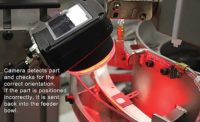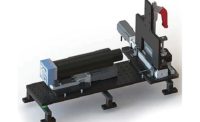Automation engineers have developed ingenious ways to mechanically singulate and orient parts in a feeder bowl. For example, if you need to feed a cylindrical part longitudinally, you can use a “wiper”—a small projection on the side of the feed track. Parts that are lying down will pass under the wiper; parts that are standing upright will be knocked over. A notch along the outside of the track will provide additional sorting. Parts that are travelling end to end along the bowl wall will bypass the notch, but parts that are travelling perpendicular to the bowl wall will encounter the notch and fall to the bottom of the bowl.
Sometimes, however, wipers, notches, gates and other mechanical tricks are not enough to singulate and orient parts. This was the situation faced recently by Suzhou Huilide Machine Co. Ltd., a manufacturer of parts feeding equipment in Suzhou, China, and an exhibitor at the 2021 ASSEMBLY Show.
A customer needed to feed flat pins to an automated assembly system at a rate of 30 parts per minute. The pins were difficult to feed because of their shape. The pin has two ends. Both ends are the same thickness and width, but one end is U-shaped while the other is rectangular. That made it difficult to sort with conventional mechanical methods.
To solve the problem, Huilide engineers designed a vibratory feeder bowl. Fabricated from 201 stainless steel, the bowl is 330 millimeters wide and the drive is 250 millimeters wide.
A vision system inspects the pins as they reach the top of the bowl. When a pin passes a certain point, a sensor triggers the camera to take a picture of the pin. The camera then compares the picture with an image of a correctly oriented pin stored in memory. If the pin is positioned correctly, it exits the bowl feeder. If it is wrong, the part will reject and return to the bowl.
After testing, the bowl met the required feed rate.
For more information, call Huilide at 86-512-6683-4790, email info@hldmachine.com or visit www.hldmachine.com.





